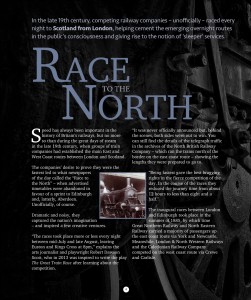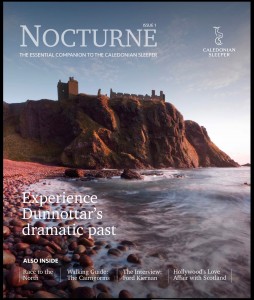
In the late 19th century, competing railway companies raced – unofficially – to Scotland from London… and helped cement the routes in the public’s consciousness.
Speed has always been important in the history of Britain’s railways, but no more so than during the great days of steam in the late 19th century, when groups of train companies had established the main East and West Coast routes between London and Scotland. The companies’ desire to prove they were the fastest led to what newspapers of the day called the “Race to the North” – when advertised timetables were abandoned in the determination to reach Edinburgh, and later Aberdeen, first.
The inaugural races between London and Edinburgh took place in the summer of 1885, by which time Great Northern Railway and North Eastern Railway carried a majority of passengers up the east coast route via York and Newcastle, while London and North Western Railways and Caledonian Railway Company competed on the west coast route via Crewe and Carlisle.
 Before the two companies met to agree a return to normal timetables, it was generally felt that the West Coast trains – despite being faced with a longer route – had made the better times. The competitive fever was reignited, however, in 1890 – thanks to the completion and opening of the Tay and Forth Bridges.
Before the two companies met to agree a return to normal timetables, it was generally felt that the West Coast trains – despite being faced with a longer route – had made the better times. The competitive fever was reignited, however, in 1890 – thanks to the completion and opening of the Tay and Forth Bridges.
“The building of the Tay and Forth Bridges at last gave the east coast companies a direct route to Aberdeen instead of having to go via Stirling, Perth and the vale of Strathmore and use the track that belonged to their competitors,” explains the arts journalist and playwright Robert Dawson Scott, whose 2013 play The Great Train Race was recently revived in Galashiels.
“The races took place more or less every night between mid July and late August, leaving Euston and Kings Cross at 8pm,” he explains. “It was never officially announced but, behind the scenes, both sides were out to win. You can still find the details of the telegraph traffic on the east cost in the archives of the North British Railway Company – which ran the trains north of the border on the east coast route – showing the lengths they were prepared to go to. Being fastest gave the best bragging rights in the fierce competition of the day. In the course of the races they reduced the journey time from about 12 hours to less than eight and a half.”
Robert insists he’s no trainspotter, but was nevertheless fascinated by the idea of the races. “It’s all quite well documented when you start to look,” he says. “One of the locomotives involved, engine Hardwicke (which covered the bit between Crewe and Carlisle, over the Shap fell summit) is preserved in the National Railway Museum in York. It’s surprisingly small compared to the massive machines which set all the records for steam trains in the 1930s. The detail that really caught my eye, though, is that on one night in August, the two racing trains were so evenly matched over 500 miles or so that, as they converged on the final junction just north of Montrose, that they could see each other across the Montrose basin in the dawn’s early light.”
While railway privatisation in the 1990s meant that the East and West Coast routes were once again in the hands of different companies, the return of such competitions was unlikely. “It was of its time because so much depended on the skill and brawn of the engine drivers and their firemen, coaxing the best possible performance out of their machines,” insists Robert. “Nowadays, trains glide up and down the gradients as if they weren’t there. Also, it’s simply inconceivable that it could happen today; the regulations around train operating are – thank goodness – much stricter!”
First published in Nocturne #1 (Winter 2015/16)